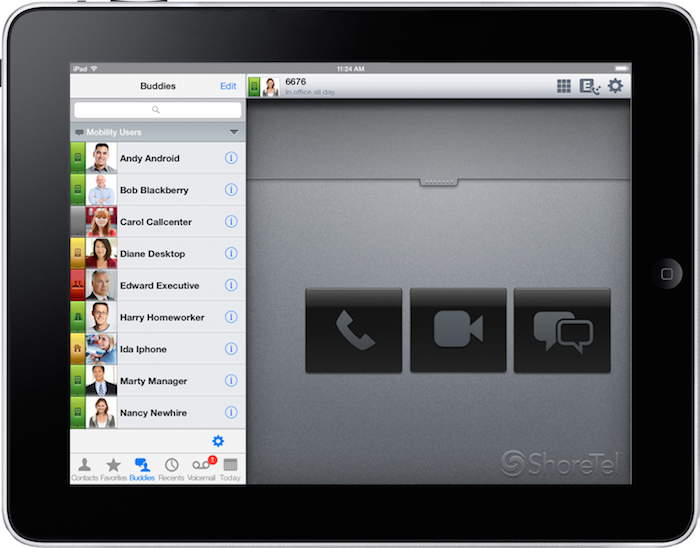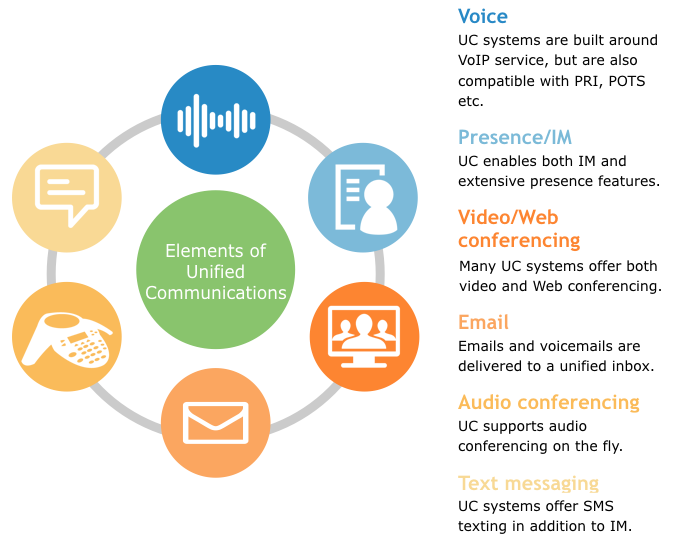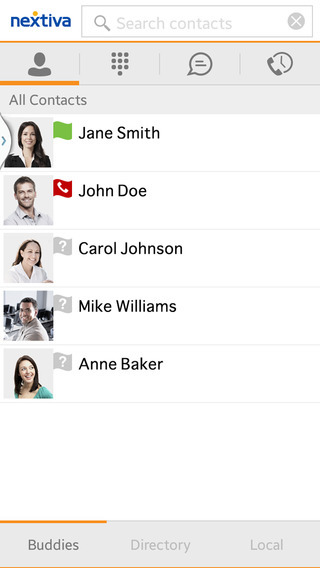Find the best UCaaS Providers
Compare Products
Showing 1 - 20 of 227 products
Sort by
Reviews: Sorts listings by the number of user reviews we have published, greatest to least.
Sponsored: Sorts listings by software vendors running active bidding campaigns, from the highest to lowest bid. Vendors who have paid for placement have a ‘Visit Website’ button, whereas unpaid vendors have a ‘Learn More’ button.
Avg Rating: Sorts listings by overall star rating based on user reviews, highest to lowest.
A to Z: Sorts listings by product name from A to Z.
Intermedia Unite
Intermedia Unite
Intermedia Unite is a cloud-based voice over internet protocol (VoIP) solution that provides small to large enterprises with several tools to streamline business communications. The centralized platform enables users to send messa...Read more about Intermedia Unite
RingCentral MVP
RingCentral MVP
RingEX is a cloud-based business communications solution that offers tools for Messaging, Video and Phone. Core features of the solution include conferencing, auto-recording and unlimited long-distance and local calling. RingEX ...Read more about RingCentral MVP
Ooma Office
Ooma Office
Ooma Office is a cloud-based voice + video solution suitable for businesses of all sizes. The platform includes a full suite of business phone features designed to deliver a flawless communications experience and advance team coll...Read more about Ooma Office
Dialpad
Dialpad
Dialpad is an AI-powered cloud communication platform and business phone system that provides organizations with the latest in VoIP telephony technology to keep teams connected and productive. The platform comprises three integrat...Read more about Dialpad
Talk with us for a free
15-minute consultationSoftware Advice is free because vendors pay us when they receive sales opportunities.
This allows us to provide comprehensive software lists and an advisor service at no cost to you.
This allows us to provide comprehensive software lists and an advisor service at no cost to you.
Meet Eric, a software expert who has helped 1,534 companies select the right product for their needs.
Talk with us for a free
15-minute consultationSoftware Advice is free because vendors pay us when they receive sales opportunities.
This allows us to provide comprehensive software lists and an advisor service at no cost to you.
This allows us to provide comprehensive software lists and an advisor service at no cost to you.
Tell us more about your business and an advisor will reach out with a list of software recommendations customized for your specific needs.
STEP 1 OF 4
How many phones do you have?
Nextiva
Nextiva
Nextiva brings customers and teams closer by connecting conversations in one AI-powered platform. We connect businesses to all of their conversations, helping them understand their customers in real-time to create personalized exp...Read more about Nextiva
ULTATEL Cloud Business Phone System
ULTATEL Cloud Business Phone System
ULTATEL enables people to work together and get the information they need to do their best work, anywhere they are. Our cloud platform brings together phone, video, messaging, texts and business apps, allowing people to connect, ...Read more about ULTATEL Cloud Business Phone System
Slack
Slack
Slack is a cloud-based project collaboration and team interaction tool designed to facilitate communication across organizations. The solution caters to various industries, including media, research, technology, education, financi...Read more about Slack
Zoom
Zoom
Zoom is an all-in-one intelligent collaboration platform that makes connecting easier, more immersive, and more dynamic for businesses and individuals. Zoom technology puts people at the center, enabling meaningful connections, fa...Read more about Zoom
GoTo Meeting
GoTo Meeting
An industry leader in online video conferencing for companies around the world, GoTo Meeting now comes as part of GoTo Connect, the all-in-one communications software built for SMBs. The Meeting solution, available to buy standalo...Read more about GoTo Meeting
Microsoft Teams
Microsoft Teams
Microsoft Teams is a cloud-based group chat solution that helps teams collaborate on documents. Its key features include messaging, conferencing and file sharing. Microsoft Teams has replaced Skype for Business as Microsoft's onli...Read more about Microsoft Teams
Webex
Webex
Webex brings together Calling, Meeting and Messaging modes of collaboration into a seamless, engaging, inclusive and intelligent experience. Seamless collaboration across devices, locations and organizations • Use any computer, t...Read more about Webex
LiveAgent
LiveAgent
LiveAgent is an online Help Desk solution for e-commerce businesses at the small and midsize levels. The platform offers live chat application, ticket management, online self-service portals, and change and license management, all...Read more about LiveAgent
NetSuite
NetSuite
With an integrated system that includes ERP, financials, commerce, inventory management, HR, PSA, supply chain management, CRM and more – NetSuite enables fast-growing businesses across all industries to work more effectively by a...Read more about NetSuite
Workplace from Meta
Workplace from Meta
Workplace is a communication tool that connects everyone, whether they’re behind a desk, in front of customers, or working from home. Share important updates with teams, regions, or companies in official Groups. Send instant ...Read more about Workplace from Meta
Bitrix24
Bitrix24
Bitrix24 is an online workspace for small, medium, and large businesses. It features over 35 cross-integrated tools, including CRM, tasks, Kanban board, Gantt chart, messenger, video calls, file storage, workflow automation, and m...Read more about Bitrix24
GoTo Connect
GoTo Connect
GoTo Connect is the all-in-one phone, meeting and messaging software built for SMBs. It boasts an enterprise-class phone system with 100+ features with inclusive minutes for local, long distance & international calls; video and au...Read more about GoTo Connect
Userlike
Userlike
Userlike is the leading software for live chat and customer messaging in Germany that offers businesses a central inbox for all messaging channels such as website chat, WhatsApp, Facebook Messenger, SMS and more. From here, all me...Read more about Userlike
Weave
Weave
Weave is the all-in-one customer communication and engagement platform for small- and medium-sized businesses. From the first phone call to the final invoice and every touchpoint in between, Weave connects the entire customer jour...Read more about Weave
3CX
3CX
3CX Phone System is an open standards communications solution, suitable for any sized business that wants all the features of an advanced contact center at a fraction of the cost. 3CX can take your business communications to the n...Read more about 3CX
Ringover
Ringover
Ringover is the no.1 business phone system that gives you unlimited calls to 110 countries, video conferencing, SMS and group messaging, call recording, call whispering and more features focused on improving your teams productivit...Read more about Ringover
Popular Comparisons
Buyers Guide
Last Updated: March 16, 2023“Unified communications” (UC) is a buzzword for technologies that connect voice, email, text messaging, instant messaging (IM) and other business communication channels through intuitive user interfaces and software integrations. UC software systems focus communications functionality around the end user and provide a consistent experience across multiple devices (laptops, IP phones, smartphones, tablets, headsets etc.).
Unified-Communications-as-a-Service (UCaaS), meanwhile, is simply a term for cloud-based UC, which is typically delivered on a subscription basis (in other words, you pay per-month rates for user licenses instead of one-time license fees).
This guide is intended to help you research UCaaS solutions for your organization. It covers the following topics:
What Are Unified Communications and UCaaS?
On-Premise UC, UCaaS and Hybrid Deployment Models
What Are Unified Communications and UCaaS?
Traditional business phone systems primarily focused on managing the voice channel. This created a disjointed experience for employees who had to use other applications for email, instant messaging and so on. Moreover, these systems didn’t offer the flexible configuration settings users need to personalize their various communication methods. Even worse, legacy phone systems were difficult to integrate with other types of business software.
UC emerged around the turn of the millennium, as phone systems designed for VoIP service began to evolve in response to these issues. Unlike traditional phone systems, UC systems put users at the heart of communications. These systems allowed users to manage all workplace communications from a single system with a unified interface, accessible through tablets, smartphones, laptops and a range of other devices.

iPad video conferencing with ShoreTel Mobility 8
In addition to streamlining the user experience across devices, UC systems and cloud-based UCaaS systems also help users manage communications by providing real-time control over their contact preferences (e.g., whether they’re available for a phone conversation). Moreover, UC and UCaaS systems can integrate with customer relationship management (CRM) systems, accounting systems and other vital software categories to add communications capabilities to workflows involving multiple types of software.
The net result in successful UC implementation: new possibilities for collaboration throughout your organization. UC can also reduce the costs associated with using multiple communication systems. For example, instead of paying for a phone system, a video conferencing system and a stand-alone audio conferencing service, under UC, businesses only need a single communications provider.
Here are the most important communications channels managed by UC and UCaaS software systems:

This is just a high-level overview of the basic modes of communication handled by these systems; it is not an exhaustive listing of capabilities. UC and UCaaS systems are capable of extensive functionality and are quite technically complex, with administrator manuals that can be thousands of pages long.
The first UC systems required the deployment of physical hardware, such as servers and switches, on businesses’ premises. Now, organizations can choose between deploying UC on-premise, in the cloud (UCaaS) or both.
On-Premise UC, UCaaS and Hybrid Deployment
The choice between UCaaS and on-premise UC is an important one. Whereas UC was once confined to enterprises with very deep pockets, UCaaS providers make the technology affordable for a much wider range of organizations by significantly cutting upfront costs. UCaaS solutions can also be easier to manage for organizations with limited IT resources.
On the other hand, on-premise UC systems have disaster survivability benefits: They allow for redundant connections to the public switched telephone network (PSTN) for maintaining service during Internet outages.
Some UC and UCaaS providers allow for cloud deployments at certain sites (such as branch locations) and on-premise deployments at others (such as campuses). This is known as the hybrid deployment model.
In the hybrid model, even though the system has been deployed in different ways across multiple sites, it’s still a single system that can be centrally administered (typically, from the main campus). In addition to survivability benefits, hybrid deployments allow businesses to continue using legacy communications equipment in which they’ve already invested heavily.
You’ll need to factor in networking requirements, legacy investments and organizational structure along with costs when deciding whether to go with on-premise, UCaaS or hybrid deployment.
The systems listed on this page are all UCaaS products.
UCaaS Functionality
The following table lists some additional capabilities of UC and UCaaS systems:
Administrator console | Administrators have a unified interface for controlling applications and features, as well as for managing the organization’s dial plan across multiple locations and networks. |
Desktop client | Clients are installed on end users’ desktops or laptops. Users can communicate across multiple channels, and manage both contact preferences and call routing preferences via the client. |
Mobile client | Extends major communication channels, such as voice calling, instant messaging, email and conferencing, to mobile devices. Users can make and receive calls with mobile devices using their work numbers. Mobile clients also allow users to access the system remotely to manage settings and preferences. |
Single identity number | Users make and receive calls using a single work number, regardless of whether they’re communicating on a softphone, headset, IP desk phone, smartphone, tablet etc. |
Mass notification | UC systems can handle mass notifications in emergency scenarios with capabilities such as SMS blasting. |
API | Most UC platforms offer APIs for extending the functionality of the system through the development of custom applications or integrations. |

Buddy list in Nextiva’s VoIP App Interface
Key Considerations for Buyers
The UC marketplace is complex and continually evolving. Keep the following considerations in mind while evaluating vendors to home in on the systems that will best meet your needs.
Integrations with office productivity suites. Increasingly, UCaaS providers are developing pre-built integrations with popular office productivity suites, including Microsoft Office 365 and Google Apps for Work. (Such integrations were once a niche filled by middleware vendors.) If you’re already locked into the Google or Microsoft ecosystem, look for vendors that have already done the work of integration so you don’t have to.
Combined UC/contact center deployments. Some UCaaS providers also specialize in deployments for multi-channel contact centers (those that handle communications channels such as email, SMS text, instant messaging, live chat, social media etc.). These vendors can deploy a contact center system that integrates seamlessly with the UC system used by the rest of your organization. Example vendors include RingCentral, ShoreTel, Nextiva, 8x8 and Jive.
Conferencing requirements. The continued evolution of Web conferencing has vastly reduced the costs and technological complexity of both audio and video conferencing. However, UC solutions still differ in the conferencing capabilities they offer users. For instance, not all vendors’ mobile clients can support multi-party video conferencing on tablets and smartphones. Others are limited in their Web conferencing features.
In particular, the use of WebRTC (an API for browser-based video conferencing) is still evolving. Vendors are actively developing solutions based on WebRTC, while solutions already on the market have implemented it to widely varying degrees. Make sure your short list only includes vendors that offer the conferencing features you need to support your business’s collaboration styles.







